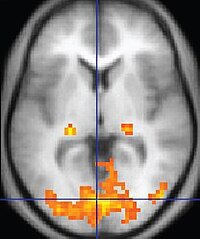
Photo from wikipedia
F unctional magnetic resonance imaging (fMRI) measures neural activity indirectly via the changes in the blood-oxygenation-level-dependent (BOLD) signal. It has been widely used by cognitive neu-roscientists and psychologists to examine… Click to show full abstract
F unctional magnetic resonance imaging (fMRI) measures neural activity indirectly via the changes in the blood-oxygenation-level-dependent (BOLD) signal. It has been widely used by cognitive neu-roscientists and psychologists to examine the neural correlates of higher cognitive functions in humans, such as decision-making, emotion regulation , social interactions and consciousness. Over the years, fMRI methods have become more refined, both in terms of the spatial and temporal resolution of imaging data and in terms of the statistical approaches used to analyze them. Researchers are no longer limited to making differential measurements of neural responses to various stimuli or task demands. Rather, current practices include decoding the information content from neural activations and using patterns of neural connectivity to predict an individual's cognitive abilities and traits. Despite this remarkable progress, there are inherent challenges in fMRI studies. For example, we currently do not know the exact relationship between neuronal activity and the BOLD signal, making it hard to draw causal conclusions. Additionally, humans are highly variable in their task performance and their neural activity, as these can be influenced by mood, level of alertness, motivation, health and other factors. Finally, fMRI's dependence on image-processing pipelines and statistical analysis routines opens the door to any number of errors that can be introduced during the extraction of results. As a consequence, criticisms have been raised, suggesting that some fMRI findings are only modestly reproducible , incorrectly suggesting that a positive result is present (a 'false positive'). Unfortunately, such reports have unintentionally harmed this technique's reputation and called into question the merit of published fMRI research. Are these criticisms warranted and, even if the answer is 'no' , how can the scientific community address the negative connotations associated with this research? Even with the innumerable parameters that may differ between individual fMRI studies—study and task designs, scanner protocols, subject sampling, image preprocessing and analysis approaches, choice of statistical tests and thresholds, and correction for multiple comparisons, to name a few—many findings are reliably reproduced across labs. For example, the brain regions associated with valuation, affect regulation, motor control, sensory processing, cognitive control and decision-making show concordance across different fMRI studies in humans; these findings have also been supported by animal research drawing on more invasive and direct measures. These converging results should be highlighted in commentaries regarding research reproducibility, and critiques should be constructively balanced with potential solutions. In doing so, these critiques can provide …
Journal Title: Nature Neuroscience
Year Published: 2017
Link to full text (if available)
Share on Social Media: Sign Up to like & get
recommendations!